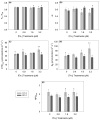Copper and Temperature Interactions Induce Differential Physiological and Metal Exclusion Responses in the Model Brown Macroalga Ectocarpus
- PMID: 40573821
- PMCID: PMC12196947
- DOI: 10.3390/plants14121834
Copper and Temperature Interactions Induce Differential Physiological and Metal Exclusion Responses in the Model Brown Macroalga Ectocarpus
Abstract
The toxic effects of copper (Cu) excess in brown macroalgae have been well characterized. However, the interactive effects of increased temperatures, associated with climate change, and Cu stress on these macrophytes remain almost unexplored. In this study, we exposed the model brown seaweed Ectocarpus to different Cu concentrations (0, 0.8, 1.6, and 3.2 μM) at two different temperatures (15 and 25 °C). Relative growth rates decreased at 25 °C for the two highest Cu concentrations after 8 days of exposure, but a contrasting pattern was observed in the photosynthetic maximum quantum yield (Fv/Fm) and photosynthetic efficiency (α), where reductions were observed at 15 °C for the same Cu concentrations. Although no differences among treatments were observed for chlorophyll a (Chla) and chlorophyll c (Chlc), a reduction in concentration of the accessory pigment fucoxanthin (Fx) was only observed at 15 °C in all Cu treatments. Interestingly, at 25 °C, 20.1% less total Cu (intracellular + extracellularly bound) accumulated compared to 15 °C upon exposure to 3.2 μM Cu. Likewise, 33.1 and 23.8% less Cu accumulated intracellularly at 25 °C after exposure to 1.6 μM and 3.2 μM Cu, respectively. Additionally, at 25 °C about half of the Cu ions accumulated intracellularly and half extracellularly compared to 15 °C, where Cu accumulated mostly intracellularly at the two highest Cu concentrations. The results presented here provide valuable information to better understand the interactive effects of increased temperature and excess Cu in the stress response of Ectocarpus, suggesting that increased temperature helps to offset the negative impacts of exposure to high Cu concentrations.
Keywords: chlorophyll a fluorescence; climate change; rapid light curves; seaweed; trace metals.
Conflict of interest statement
The authors declare no conflicts of interest.
Figures




Similar articles
-
Behavioral interventions to reduce risk for sexual transmission of HIV among men who have sex with men.Cochrane Database Syst Rev. 2008 Jul 16;(3):CD001230. doi: 10.1002/14651858.CD001230.pub2. Cochrane Database Syst Rev. 2008. PMID: 18646068
-
Systemic pharmacological treatments for chronic plaque psoriasis: a network meta-analysis.Cochrane Database Syst Rev. 2021 Apr 19;4(4):CD011535. doi: 10.1002/14651858.CD011535.pub4. Cochrane Database Syst Rev. 2021. Update in: Cochrane Database Syst Rev. 2022 May 23;5:CD011535. doi: 10.1002/14651858.CD011535.pub5. PMID: 33871055 Free PMC article. Updated.
-
Thermal stability and storage of human insulin.Cochrane Database Syst Rev. 2023 Nov 6;11(11):CD015385. doi: 10.1002/14651858.CD015385.pub2. Cochrane Database Syst Rev. 2023. PMID: 37930742 Free PMC article.
-
Systemic pharmacological treatments for chronic plaque psoriasis: a network meta-analysis.Cochrane Database Syst Rev. 2017 Dec 22;12(12):CD011535. doi: 10.1002/14651858.CD011535.pub2. Cochrane Database Syst Rev. 2017. Update in: Cochrane Database Syst Rev. 2020 Jan 9;1:CD011535. doi: 10.1002/14651858.CD011535.pub3. PMID: 29271481 Free PMC article. Updated.
-
Intravenous magnesium sulphate and sotalol for prevention of atrial fibrillation after coronary artery bypass surgery: a systematic review and economic evaluation.Health Technol Assess. 2008 Jun;12(28):iii-iv, ix-95. doi: 10.3310/hta12280. Health Technol Assess. 2008. PMID: 18547499
References
-
- Christie H., Norderhaug K., Fredriksen S. Macrophytes as Habitat for Fauna. Mar. Ecol. Prog. Ser. 2009;396:221–233. doi: 10.3354/meps08351. - DOI
-
- Costanza R., de Groot R., Sutton P., van der Ploeg S., Anderson S.J., Kubiszewski I., Farber S., Turner R.K. Changes in the Global Value of Ecosystem Services. Glob. Environ. Change. 2014;26:152–158. doi: 10.1016/j.gloenvcha.2014.04.002. - DOI
-
- Steneck R.S., Graham M.H., Bourque B.J., Corbett D., Erlandson J.M., Estes J.A., Tegner M.J. Kelp Forest Ecosystems: Biodiversity, Stability, Resilience and Future. Environ. Conserv. 2002;29:436–459. doi: 10.1017/S0376892902000322. - DOI
-
- Graham M.H. Effects of Local Deforestation on the Diversity and Structure of Southern California Giant Kelp Forest Food Webs. Ecosystems. 2004;7:341–357. doi: 10.1007/s10021-003-0245-6. - DOI
-
- Umanzor S., Ladah L., Calderon-Aguilera L.E., Zertuche-González J.A. Testing the Relative Importance of Intertidal Sea-weeds as Ecosystem Engineers across Tidal Heights. J. Exp. Mar. Biol. Ecol. 2019;511:100–107. doi: 10.1016/j.jembe.2018.11.008. - DOI
Grants and funding
LinkOut - more resources
Full Text Sources

